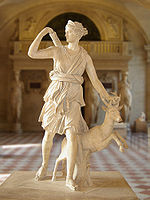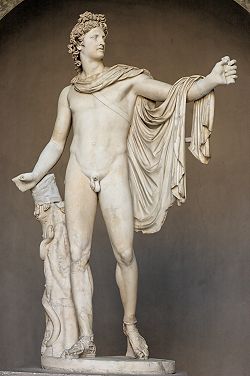
Leochares
Encyclopedia


Greeks
The Greeks, also known as the Hellenes , are a nation and ethnic group native to Greece, Cyprus and neighboring regions. They also form a significant diaspora, with Greek communities established around the world....
sculptor
Sculpture
Sculpture is three-dimensional artwork created by shaping or combining hard materials—typically stone such as marble—or metal, glass, or wood. Softer materials can also be used, such as clay, textiles, plastics, polymers and softer metals...
from Athens
Athens
Athens , is the capital and largest city of Greece. Athens dominates the Attica region and is one of the world's oldest cities, as its recorded history spans around 3,400 years. Classical Athens was a powerful city-state...
, who lived in the 4th century BC.
Works
Leochares worked at the constructionConstruction
In the fields of architecture and civil engineering, construction is a process that consists of the building or assembling of infrastructure. Far from being a single activity, large scale construction is a feat of human multitasking...
of the Mausoleum of Maussollos at Halicarnassus
Mausoleum of Maussollos
The Mausoleum at Halicarnassus or Tomb of Mausolus was a tomb built between 353 and 350 BC at Halicarnassus for Mausolus, a satrap in the Persian Empire, and Artemisia II of Caria, his wife and sister....
, one of the "Seven Wonders of the Ancient World
Seven Wonders of the Ancient World
The Seven Wonders of the World refers to remarkable constructions of classical antiquity listed by various authors in guidebooks popular among the ancient Hellenic tourists, particularly in the 1st and 2nd centuries BC...
". The Diana of Versailles
Diana of Versailles
The Diana of Versailles is a slightly over lifesize marble statue of the Greek goddess Artemis , with a deer, located in the Musée du Louvre, Paris. It is a Roman copy of a lost Greek bronze original attributed to Leochares, c...
is a Roman copy of his original (circa 325 BC). He is also thought to be the creator of the celebrated Apollo Belvedere
Apollo Belvedere
The Apollo Belvedere or Apollo of the Belvedere—also called the Pythian Apollo— is a celebrated marble sculpture from Classical Antiquity. It was rediscovered in central Italy in the late 15th century, during the Renaissance...
, of which a Roman copy is currently housed in Vatican City
Vatican City
Vatican City , or Vatican City State, in Italian officially Stato della Città del Vaticano , which translates literally as State of the City of the Vatican, is a landlocked sovereign city-state whose territory consists of a walled enclave within the city of Rome, Italy. It has an area of...
.
Of his portrait-statues, the most celebrated were those of Philip
Philip II of Macedon
Philip II of Macedon "friend" + ἵππος "horse" — transliterated ; 382 – 336 BC), was a king of Macedon from 359 BC until his assassination in 336 BC. He was the father of Alexander the Great and Philip III.-Biography:...
, Alexander, Amyntas III, Olympias
Olympias
Olympias was a Greek princess of Epirus, daughter of king Neoptolemus I of Epirus, the fourth wife of the king of Macedonia, Philip II, and mother of Alexander the Great...
, and Eurydice I, which were made of ivory and gold, and were placed in the Philippeion
Philippeion
The Philippeion in the Altis of Olympia was an Ionic circular memorial of ivory and gold, which contained statues of Philip's family, Alexander the Great, Olympias, Amyntas III and Eurydice I. It was made by the Athenian sculptor Leochares in celebration of Philip's victory at the battle of Chaeronea...
a circular building in the Altis
Altis
Altis was a location in what is today Peloponnese, Greece, on a little plain in the Elis Prefecture, on the right shore of the Alfeios River near the city of Pyrgos, around 18 kilometers away from the Ionian Sea and at the foot of Mount Cronion....
at Olympia
Olympia, Greece
Olympia , a sanctuary of ancient Greece in Elis, is known for having been the site of the Olympic Games in classical times, comparable in importance to the Pythian Games held in Delphi. Both games were held every Olympiad , the Olympic Games dating back possibly further than 776 BC...
, erected by Philip II of Macedon in celebration of his victory at Battle of Chaeronea (338 BC)
Battle of Chaeronea (338 BC)
The Battle of Chaeronea was fought in 338 BC, near the city of Chaeronea in Boeotia, between the forces of Philip II of Macedon and an alliance of Greek city-states...
.

